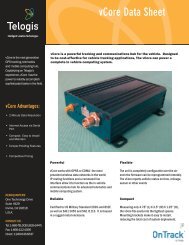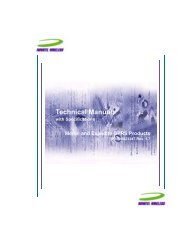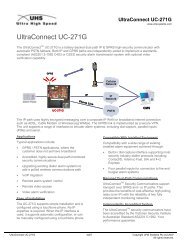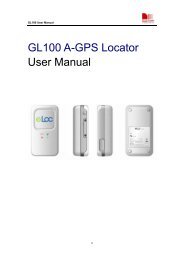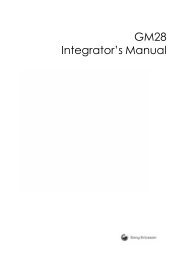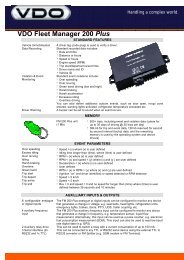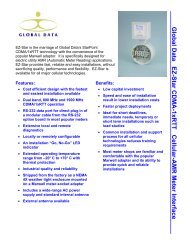Hardware Interface Description - KORE Telematics
Hardware Interface Description - KORE Telematics
Hardware Interface Description - KORE Telematics
You also want an ePaper? Increase the reach of your titles
YUMPU automatically turns print PDFs into web optimized ePapers that Google loves.
XT55/56 <strong>Hardware</strong> <strong>Interface</strong> <strong>Description</strong><br />
Confidential / Released<br />
s<br />
3.3.1.3 Turn on the GSM part of XT55/56 using the GSM_POWER signal<br />
As detailed in Chapter 3.5.4, the charging adapter can be connected regardless of the<br />
module’s operating mode (except for Alarm mode).<br />
If the charger is connected to the charger input of the external charging circuit and the<br />
module’s GSM_POWER pin while XT55/56 is off, processor controlled fast charging starts<br />
(see Chapter 3.5.3). The GSM part of XT55/56 enters a restricted mode, referred to as<br />
Charge-only mode where only the charging algorithm will be launched.<br />
During the Charge-only mode XT55/56 is neither logged on to the GSM network nor are the<br />
serial interfaces fully accessible. To switch to normal operation and log on to the GSM<br />
network, the GSM_IGT line needs to be activated.<br />
3.3.1.4 Turn on the GSM part of XT55/56 using the RTC (Alarm mode)<br />
Another power-on approach is to use the RTC, which is constantly supplied with power from<br />
a separate voltage regulator in the power supply ASIC. The RTC provides an alert function,<br />
which allows the GSM part of the XT55/56 to wake up whilst the internal voltage regulators<br />
are off. To prevent the engine from unintentionally logging into the GSM network, this<br />
procedure only enables restricted operation, referred to as Alarm mode. It must not be<br />
confused with a wake-up or alarm call that can be activated by using the same AT command,<br />
but without switching off power.<br />
Use the AT+CALA command to set the alarm time. The RTC retains the alarm time if the<br />
GSM part of XT55/56 was powered down by AT^SMSO. Once the alarm is timed out and<br />
executed, XT55/56 enters the Alarm mode. This is indicated by an Unsolicited Result Code<br />
(URC) which reads:<br />
^SYSSTART ALARM MODE<br />
Note that this URC is the only indication of the Alarm mode and will not appear when<br />
autobauding was activated (due to the missing synchronization between DTE and DCE upon<br />
start-up). Therefore, it is recommended to select a fixed baudrate before using the Alarm<br />
mode. In Alarm mode only a limited number of AT commands is available. For further<br />
instructions refer to the AT Command Set.<br />
Table 5: AT commands available in Alarm mode<br />
AT command<br />
AT+CALA<br />
AT+CCLK<br />
AT^SBC<br />
AT^SCTM<br />
AT^SMSO<br />
Function<br />
Set alarm time<br />
Set date and time of RTC<br />
In Alarm mode, you can only query the present current consumption and check<br />
whether or not a charger is connected. The battery capacity is returned as 0,<br />
regardless of the actual voltage (since the values measured directly on the cell are<br />
not delivered to the module).<br />
Query temperature range, enable/disable URCs to report critical temperature<br />
ranges<br />
Power down GSM engine<br />
For the GSM engine to change from the Alarm mode to full operation (normal operating<br />
mode) it is necessary to drive the ignition line to ground. This must be implemented in your<br />
host application as described in Chapter 3.3.1.1.<br />
XT55/56_hd_v02.06a Page 33 of 125 17.12.2004



